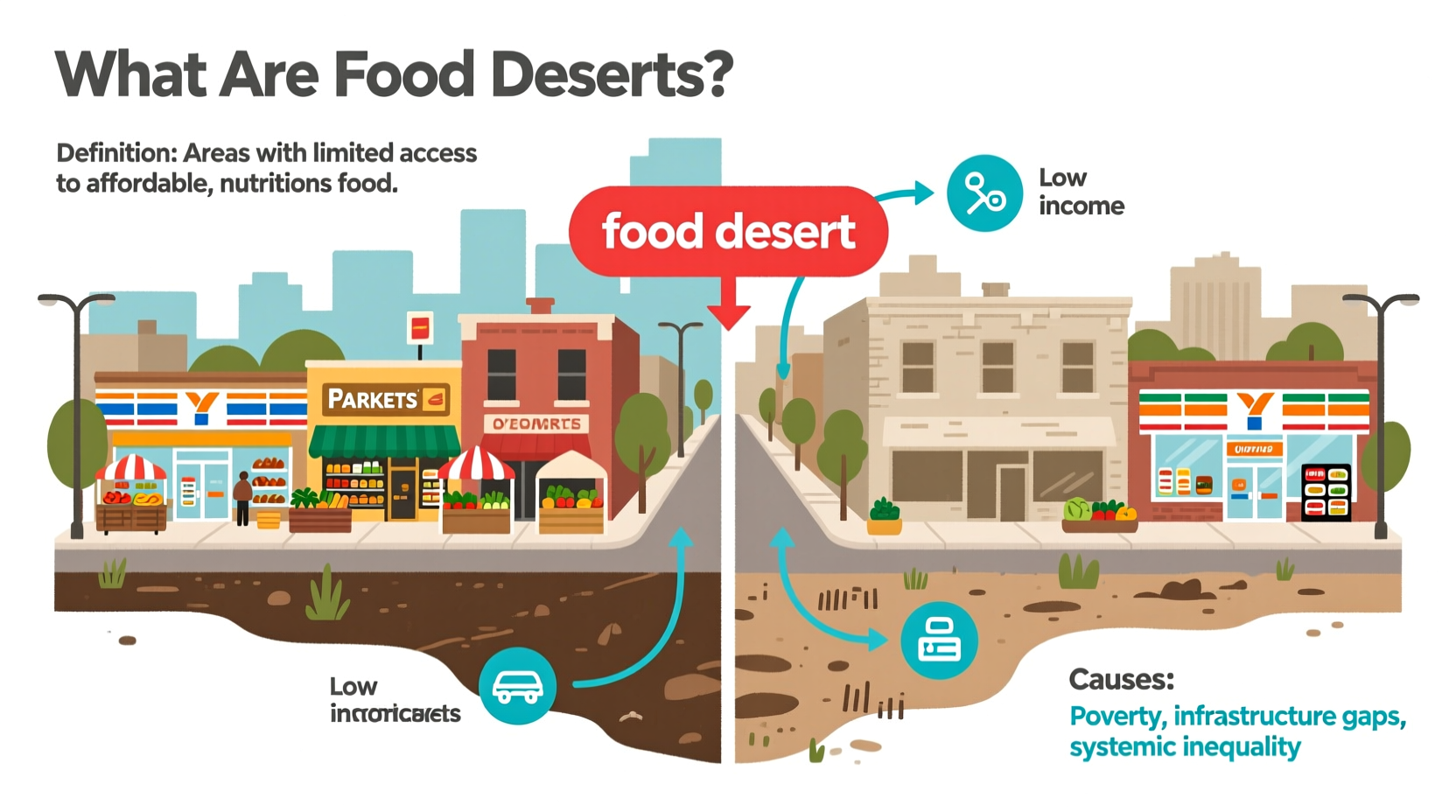Understanding food deserts isn't just academic—it directly impacts your health, community resources, and daily food choices. If you've ever wondered why certain neighborhoods lack grocery stores or how food access affects your family's wellbeing, this guide delivers the facts you need to recognize and address these critical gaps in our food system.
What Exactly Defines a Food Desert?
While "food desert" has become common terminology, the official USDA definition specifies two key criteria that must both be met:
| Criteria | Urban Areas | Rural Areas |
|---|---|---|
| Distance from grocery source | More than 1 mile | More than 10 miles |
| Population threshold | At least 33% of residents | At least 33% of residents |
| Low-income requirement | Average poverty rate ≥ 20% OR median family income ≤ 80% of area median | Average poverty rate ≥ 20% OR median family income ≤ 80% of area median |
This precise definition matters because not all neighborhoods with limited grocery options qualify as official food deserts. Areas might have convenience stores or fast food but still have residents who can easily access supermarkets within the specified distances. The term specifically refers to areas where distance AND economic barriers combine to create significant access challenges.
Mapping America's Food Deserts: Where They Exist
Food deserts aren't evenly distributed across the United States. Research from the USDA Economic Research Service reveals distinct patterns:
- Urban food deserts typically appear in historically redlined neighborhoods with concentrated poverty, often in inner-city areas of major metropolitan regions
- Rural food deserts frequently occur in economically depressed regions like the Mississippi Delta, Appalachia, and Native American reservations
- Racial disparities are pronounced—predominantly Black neighborhoods have about half as many supermarkets as predominantly white neighborhoods with similar income levels
A 2022 study published in the American Journal of Preventive Medicine found that predominantly Black census tracts had 2.4 times more convenience stores but 4.3 times fewer supermarkets than predominantly white tracts. This structural inequality creates environments where unhealthy food options dominate while nutritious alternatives remain physically and financially out of reach.
Why Food Deserts Form: Underlying Causes
Food deserts don't emerge randomly—they result from interconnected economic, historical, and policy factors:
Supermarket Redlining
Major grocery chains often avoid opening stores in low-income neighborhoods due to perceived lower profitability, higher security costs, and complex real estate challenges. This practice, sometimes called "supermarket redlining," mirrors historical housing discrimination patterns. According to research from the Food Research & Action Center, grocery stores require population densities of 10,000-15,000 people within a 5-mile radius to operate profitably—a threshold many underserved neighborhoods don't meet.
Transportation Barriers
Without reliable transportation, the "1 mile" standard becomes a significant obstacle. The Brookings Institution reports that 46% of food desert residents lack vehicle access, and public transportation routes often don't connect residential areas with grocery stores. In rural food deserts, the problem intensifies—traveling 10+ miles for groceries consumes valuable time and transportation resources many families don't have.
Economic Development Patterns
Decades of disinvestment in certain neighborhoods created conditions where small corner stores (stocking primarily processed foods) became the primary food source. The Federal Reserve Bank of Chicago notes that these areas often suffer from "retail flight" where businesses leave due to economic downturns, creating self-perpetuating cycles of limited food access.
Real Health Consequences of Limited Food Access
Living in a food desert isn't merely inconvenient—it directly impacts health outcomes. Research from the Centers for Disease Control and Prevention shows residents of food deserts face:
- 23% higher rates of obesity compared to those with easy supermarket access
- 32% increased likelihood of developing type 2 diabetes
- Higher rates of cardiovascular disease and related complications
- Nutritional deficiencies affecting children's cognitive development
These health disparities persist even when controlling for individual income levels, suggesting that neighborhood food environment independently influences health outcomes. A landmark study in the American Journal of Epidemiology followed residents who moved from food deserts to areas with better food access and documented measurable improvements in dietary quality within just six months.

Addressing Food Deserts: Current Solutions
Communities and policymakers have developed multiple approaches to combat food deserts, with varying degrees of success:
Grocery Store Incentives
The federal Healthy Food Financing Initiative has helped bring supermarkets to underserved areas by providing grants and loans. Since 2011, this program has supported over 1,000 projects creating or expanding grocery access for 17 million people. Local governments have also implemented tax abatements and streamlined permitting to encourage grocery development in food deserts.
Mobile Markets and Food Trucks
Mobile grocery services bring fresh produce directly to neighborhoods. The Fresh Moves Mobile Market in Chicago, operating from a retrofitted bus, serves over 2,000 residents monthly in areas previously without fresh food access. Similar programs have launched in cities from Los Angeles to Baltimore, often partnering with local farmers.
Community Initiatives
Grassroots efforts like community gardens, food co-ops, and farmers' markets accept SNAP benefits and provide affordable fresh produce. The Detroit Black Community Food Security Network operates an urban farm producing over 10,000 pounds of food annually for residents. These hyperlocal solutions build community resilience while addressing immediate food access needs.
Determining If You're in a Food Desert
Wondering about your own food access? Consider these practical indicators:
- Do you need to travel more than 1 mile (urban) or 10 miles (rural) to reach a full-service grocery store?
- Does your nearest food source primarily sell convenience items rather than fresh produce?
- Do transportation challenges make grocery shopping difficult or time-consuming?
- Do healthy food options cost significantly more at your nearest stores compared to supermarkets elsewhere?
The USDA's Food Access Research Atlas provides an interactive map where you can enter your address to determine if you live in a designated food desert. Many local health departments also offer food access assessments for community planning purposes.
Looking Forward: Sustainable Food Access
While bringing supermarkets to underserved areas helps, experts increasingly recognize that true food justice requires addressing systemic issues. The most successful initiatives combine physical access improvements with nutrition education, economic development, and policy changes that address the root causes of food insecurity.
Emerging approaches include supporting food sovereignty movements, expanding SNAP benefits for fruits and vegetables through programs like Double Up Food Bucks, and integrating food access planning into broader community development strategies. As researchers at Johns Hopkins Bloomberg School of Public Health note, "Sustainable solutions require treating food access as infrastructure—essential to community health just like transportation, water, and energy systems."











 浙公网安备
33010002000092号
浙公网安备
33010002000092号 浙B2-20120091-4
浙B2-20120091-4